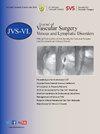Evidence for causal effects of neuropsychiatric conditions on risk of venous thromboembolism: A univariable and multivariable Mendelian randomization study
IF 2.8
2区 医学
Q2 PERIPHERAL VASCULAR DISEASE
Journal of vascular surgery. Venous and lymphatic disorders
Pub Date : 2024-04-15
DOI:10.1016/j.jvsv.2024.101889
引用次数: 0
Abstract
Background
Substantial observational evidence suggests an association between neuropsychiatric conditions and venous thromboembolism (VTE). However, the causal relationship between these two conditions requires further investigation. Therefore, we used a two-sample Mendelian randomization (MR) approach to assess the bidirectional causal effects between four neuropsychiatric conditions and VTE, deep vein thrombosis, and pulmonary embolism (PE).
Methods
Genetic variants associated with four neuropsychiatric conditions (ie, schizophrenia, major depressive disorder [MDD], bipolar disorder, and epilepsy) and VTE, deep vein thrombosis, and PE were selected. Bidirectional univariable and multivariable MR methods were applied to evaluate the causal relationships among these conditions. The primary causal estimates were obtained using the inverse variance weighted method with multiplicative random effects, supplemented by MR Egger regression, weighted median, simple mode, and weighted mode. Sensitivity analysis was conducted using the MR pleiotropy residual sum, funnel plots, and outlier (MR pleiotropy and residual sum and outlier) method.
Results
Univariable MR results showed that genetic susceptibility to MDD increases the risk of VTE and PE (VTE: odds ratio [OR], 1.25; 95% confidence interval [CI], 1.08-1.46; P = .004; PE: OR, 1.36; 95% CI, 1.09-1.69; P = .006) and that PE has an adverse causal effect on MDD (OR, 1.02; 95% CI, 1.00-1.04; P = .026). Adjustment for confounders such as obesity, sleep duration, smoking, physical activity, and alcohol consumption revealed that increased genetic susceptibility to MDD is also associated with VTE and PE.
Conclusions
Our results suggest that genetic susceptibility to MDD might have an adverse causal effect on the risk of VTE and PE and that PE has a reverse causal effect on MDD. Prevention and early diagnosis of depression are crucial in the management of VTE and PE.
神经精神疾病对静脉血栓栓塞风险的因果效应证据:单变量和多变量孟德尔随机化研究。
背景大量观察证据表明,神经精神疾病与静脉血栓栓塞症(VTE)之间存在关联。然而,这两种情况之间的因果关系还需要进一步研究。因此,我们采用了双样本孟德尔随机化(MR)方法来评估四种神经精神疾病与 VTE、深静脉血栓和肺栓塞(PE)之间的双向因果效应。方法筛选出与四种神经精神疾病(即精神分裂症、重度抑郁障碍 [MDD]、双相情感障碍和癫痫)和 VTE、深静脉血栓和 PE 相关的遗传变异。采用双向单变量和多变量磁共振方法评估这些病症之间的因果关系。主要的因果关系估计值是采用具有乘法随机效应的反方差加权法,并辅以 MR Egger 回归、加权中位数、简单模式和加权模式得出的。使用 MR 多效应残差和、漏斗图和离群值(MR 多效应和残差和离群值)方法进行了敏感性分析。结果可变 MR 结果显示,MDD 遗传易感性会增加 VTE 和 PE 的风险(VTE:几率比 [OR],1.25;95% 置信区间 [CI],1.08-1.46;P = .004;PE:OR,1.36;95% CI,1.09-1.69;P = .006),PE 对 MDD 有不利的因果影响(OR,1.02;95% CI,1.00-1.04;P = .026)。对肥胖、睡眠时间、吸烟、体力活动和饮酒等混杂因素进行调整后发现,MDD 遗传易感性的增加也与 VTE 和 PE 相关。预防和早期诊断抑郁症对于治疗 VTE 和 PE 至关重要。
本文章由计算机程序翻译,如有差异,请以英文原文为准。
求助全文
约1分钟内获得全文
求助全文
来源期刊

Journal of vascular surgery. Venous and lymphatic disorders
SURGERYPERIPHERAL VASCULAR DISEASE&n-PERIPHERAL VASCULAR DISEASE
CiteScore
6.30
自引率
18.80%
发文量
328
审稿时长
71 days
期刊介绍:
Journal of Vascular Surgery: Venous and Lymphatic Disorders is one of a series of specialist journals launched by the Journal of Vascular Surgery. It aims to be the premier international Journal of medical, endovascular and surgical management of venous and lymphatic disorders. It publishes high quality clinical, research, case reports, techniques, and practice manuscripts related to all aspects of venous and lymphatic disorders, including malformations and wound care, with an emphasis on the practicing clinician. The journal seeks to provide novel and timely information to vascular surgeons, interventionalists, phlebologists, wound care specialists, and allied health professionals who treat patients presenting with vascular and lymphatic disorders. As the official publication of The Society for Vascular Surgery and the American Venous Forum, the Journal will publish, after peer review, selected papers presented at the annual meeting of these organizations and affiliated vascular societies, as well as original articles from members and non-members.
 求助内容:
求助内容: 应助结果提醒方式:
应助结果提醒方式:


